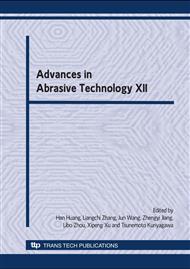p.618
p.624
p.630
p.635
p.641
p.645
p.651
p.657
p.664
Test of Focusing and Superposition for Variable Strength Activation of Coolant in Precision Machining
Abstract:
To allow better machining heat transfer through mist evaporation, a new active cooling method is proposed. It is based on variable strength activation of coolant together with active cooling. A key issue in the proposed method is the use of multiple actuators of high frequency vibration for extra strength increase. This will rely on the idea of focusing and superposition. In this project, experimental tests were conducted to test the idea for the proposed variable strength activation of coolant in precision machining. Experimental test results show that the effects of ejection distance de on the vibration sensor output amplitude Aa and output frequency fa are not significant. The output amplitude Aa has a linear relationship with the number of actuator na. The effects of na on fa is not obvious. Based on the results, the idea of using multiple actuators for focusing and constructive superposition in variable strength activation is confirmed.
Info:
Periodical:
Pages:
641-644
Citation:
Online since:
June 2009
Price:
Сopyright:
© 2009 Trans Tech Publications Ltd. All Rights Reserved
Share:
Citation:


